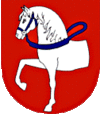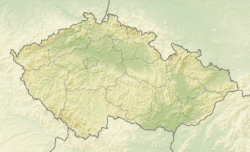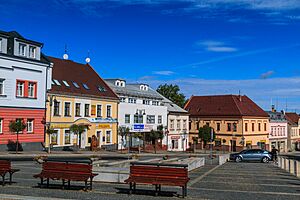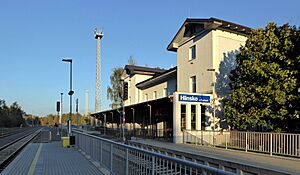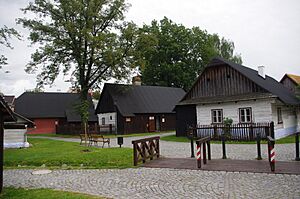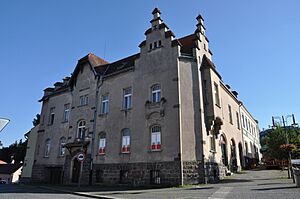Hlinsko facts for kids
Quick facts for kids
Hlinsko
|
|||
|---|---|---|---|
|
Town
|
|||
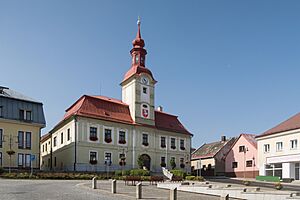
Town hall
|
|||
|
|||
| Country | |||
| Region | Pardubice | ||
| District | Chrudim | ||
| First mentioned | 1349 | ||
| Area | |||
| • Total | 24.27 km2 (9.37 sq mi) | ||
| Elevation | 582 m (1,909 ft) | ||
| Population
(2024-01-01)
|
|||
| • Total | 9,577 | ||
| • Density | 394.60/km2 (1,022.02/sq mi) | ||
| Time zone | UTC+1 (CET) | ||
| • Summer (DST) | UTC+2 (CEST) | ||
| Postal code |
539 01
|
||
Hlinsko is a town in the Czech Republic. It's located in the Pardubice Region, specifically in the Chrudim District. About 9,600 people live here. A special part of Hlinsko, called Betlém, has very old and well-preserved buildings. These buildings show traditional folk architecture and are protected as a 'village monument reservation'.
Contents
Parts of Hlinsko
Hlinsko is made up of several smaller parts and villages. These include Blatno, Čertovina, Chlum, Kouty, and Srní. One of these, Chlum, is a bit unusual because it's a separate piece of land that belongs to Hlinsko. It is not directly connected to the main town area.
What's in a Name?
The name Hlinsko comes from the Czech word hlína. This word means 'clay'. The town got its name because the area had lots of good quality clay. This clay was perfect for making pottery.
Where is Hlinsko?
Hlinsko is located in the eastern part of the Czech Republic. It is about 21 kilometers (13 miles) south of Chrudim. It is also about 30 kilometers (19 miles) south of Pardubice. The town sits in the Iron Mountains. Part of it is even in a protected natural area. The highest point in Hlinsko is 678 meters (2,224 feet) above sea level. The Chrudimka River flows through the town.
A Look at History
People have lived around the Chrudimka River since the 12th century. Hlinsko itself was started in the 12th century. It began as a small settlement to guard a trade route. This route connected Bohemia to Moravia.
The first time Hlinsko was written about was in 1349. A fortress in Hlinsko was first mentioned in 1413. In the 16th century, this fortress was used as a royal customhouse. This means it was a place where taxes were collected on goods.
During the time of Maria Theresa, Hlinsko became a market town. This meant it was a place where people could buy and sell goods. In 1834, it officially became a town. For a long time, the town's economy relied on farming, pottery, making wire, and weaving. The tradition of making pottery started in the 15th century. It continued until the 19th century. In 1871, a railway was built. This helped the town become more industrialized.
Economy and Industry
Hlinsko is home to a big dairy company called Mlékárna Hlinsko. This company was started in 1939. It began producing dairy products in 1943.
Getting Around
Hlinsko is the end point for two railway lines. One line comes from Pardubice. The other line comes from Havlíčkův Brod.
Culture and Traditions
Hlinsko and nearby towns are famous for their Slavic carnival parades. These parades feature people wearing special masks. In 2010, this tradition was recognized by UNESCO. It was added to their list of Intangible Cultural Heritage. This means it's a very important cultural tradition.
Places to See
Hlinsko is well-known for the Betlém Village Monument Reservation. This area has many old, well-preserved buildings. They show traditional folk architecture. These timbered and brick houses are from the 18th and early 19th centuries. The Betlém area is part of the Vysočina Open Air Museum.
The historic center of Hlinsko is Poděbradovo Square. Important buildings here include the town hall, Ježdík's House, and the old fortress. The town hall was built in 1598. It was later rebuilt in the Baroque style between 1788 and 1792. It still serves as the town hall today. Ježdík's House is a special building with unique sgraffito decorations from 1904. The old fortress, simply called The Fortress, is the oldest building in Hlinsko.
The Church of the Nativity of the Virgin Mary is a bit outside the main historic area. It was originally a Gothic church. It was rebuilt in the Baroque style between 1730 and 1745. However, part of its old Gothic tower was kept. Inside, it has a valuable baptistry from 1628.
Famous People from Hlinsko
- Emanuel Famíra (1900–1970), a sculptor
- Karel Lidický (1900–1976), a sculptor
- Jan Vokál (born 1958), a bishop
- Jan Chvojka (born 1980), a politician
Sister Cities
Hlinsko has special partnerships with other towns. These are called twin towns or sister cities.
See also
 In Spanish: Hlinsko (Chrudim) para niños
In Spanish: Hlinsko (Chrudim) para niños



